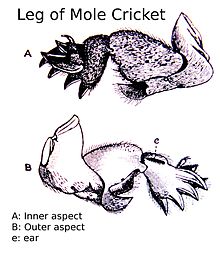Mole cricket
This article needs additional citations for verification. (June 2008) |
You can help expand this article with text translated from the corresponding article in German. (February 2011) Click [show] for important translation instructions.
|
| Mole cricket | |
|---|---|

| |
| Gryllotalpa brachyptera, Victoria, Australia | |
| Scientific classification | |
| Domain: | Eukaryota |
| Kingdom: | Animalia |
| Phylum: | Arthropoda |
| Class: | Insecta |
| Order: | Orthoptera |
| Suborder: | Ensifera |
| Superfamily: | Gryllotalpoidea |
| Family: | Gryllotalpidae Saussure, 1870 |

| |
| Distribution of the 3 main genera of Gryllotalpidae | |
The mole crickets are the family Gryllotalpidae, in the order Orthoptera (grasshoppers, locusts and crickets). Mole crickets are cylindrical-bodied insects about 3–5 centimetres (1.2–2.0 in) long, with small eyes and shovel-like forelimbs highly developed for burrowing.
Description
Mole crickets vary in size and appearance, but most of them are of moderate size for an insect, typically 3-5 cm long. They are muscular, as one may verify by holding one in the hand; they are inoffensive, but the confined insect will try to dig its way out with considerable force. The abdomen is rather soft, but the head, forelimbs, and prothorax are heavily sclerotised. The hind legs are shaped somewhat like the legs of a real cricket, but are more adapted for shoving while digging, rather than leaping, which they do rarely and poorly.
Biology
Most species of mole crickets can fly powerfully, if not agilely or casually. Usually they fly only when moving long distances, such as when changing territory. Some species of adult mole cricket may fly as far as 8 kilometres (5.0 mi) during the mating season, is active most of the year, and spends the winter in hibernation. Younger insects can have shorter wings, and their appearance varies by species, with some resembling grasshoppers or very large ants or dark-colored "termites" when wings are short.
Mole crickets are omnivores, feeding on larvae, worms, roots, and grasses. Common predators of mole crickets include birds, rats, skunks, armadillos, raccoons, foxes and blue ants.
Mole crickets are relatively common, but because they are nocturnal and spend nearly all their lives underground in extensive tunnel systems, they are rarely seen. Mole crickets amplify their song by chirping in a burrow that they've carefully sculpted into the shape of a double exponential horn, which acts as a megaphone.[1] They inhabit agricultural fields, lawns and golf courses. They are present in every continent with the exception of Antarctica, and are commonly considered pests. In East Asia, however, they are sometimes used as food (fried).
In some places, mole cricket numbers are declining due to soil erosion and habitat destruction.


Mole cricket genera
There are several genera of mole cricket, separated into tribes:
- tribus Gryllotalpini
- tribus Scapteriscini
- tribus unknown (fossil taxa)
References
- ^ (Dawkins, The Selfish Gene, pg. 63)
See also
- Camel cricket – another underground insect, with a humped back.
- Larra bicolor – parasitoid of Scapteriscus mole crickets
External links
- Mole Cricket Knowledge Base at University of Florida / Institute of Food and Agricultural Sciences
- On the University of Florida / Institute of Food and Agricultural Sciences Featured Creatures website
